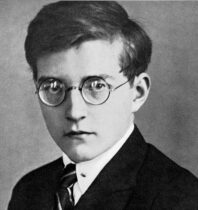In 1924, a gifted 19-year-old student at Petrograd Conservatory began his senior composition project. Soon after completion, with enthusiastic faculty recommendations, including that of the director and composer Alexander Glazunov, the First Symphony was performed by the Leningrad Philharmonic, the Berlin Philharmonic under Bruno Walter, and the Philadelphia Orchestra under Leopoldo Stokowski. Dmitri Shostakovich had become an immediate international sensation.
But the path to success was fraught with upheaval. At ten years old, his middle-class life was upended by the communist revolution, which ended 400 years of the Romanov dynasty.
Shostakovich and his family endured famine and fuel shortages. After his father died, he helped bring in extra money by improvising on piano at silent movie theaters. (Despite his ambivalence about the medium, he became a fan of Charlie Chaplin and Buster Keaton.) This job developed Shostakovich’s fluency in translating drama and story into musical language, so it is unsurprising that the piano, typically not found in the orchestra, is one of the most prominent instruments. The piano provides expressive melodic sweeps and aggressive punctuation — sometimes commenting on the action (like a film) and at other times being the main focus.
Shostakovich’s distinct and original musical voice is already present in Symphony No. 1. While less known than many of his later works, it’s a thrilling piece full of sardonic edginess, pained introspection and dramatic outbursts, and closing with a blaring finale. Shostakovich’s works should always be a little rough around the edges — especially the musical outpourings of an unstable teenager whose world was uncontrollably changing. We hope you are captivated by his power, seduced by his wit, and enchanted by his many musical surprises.
Symphony No. 1
In F Minor, Op. 10
Composed in 1924-1925
By Dmitri Shostakovich







